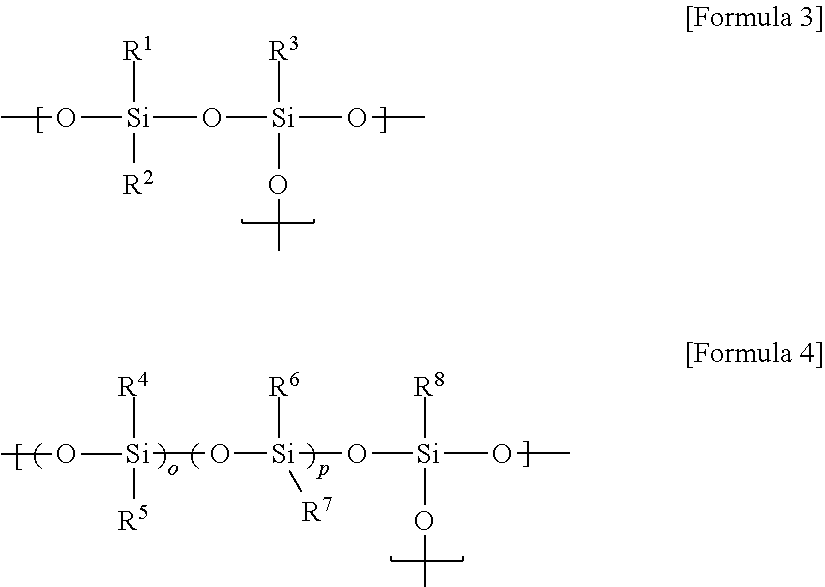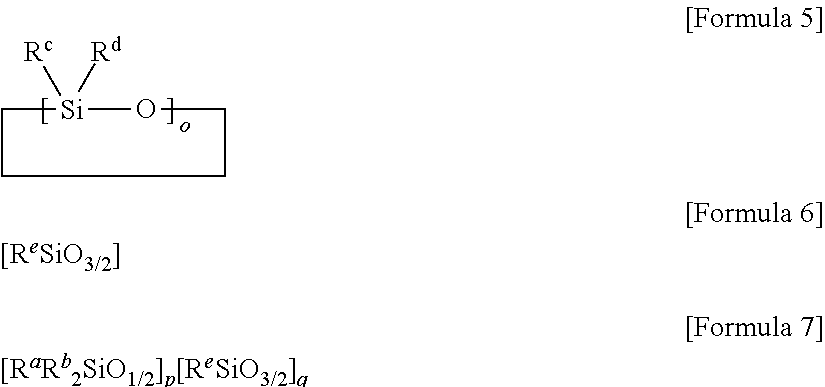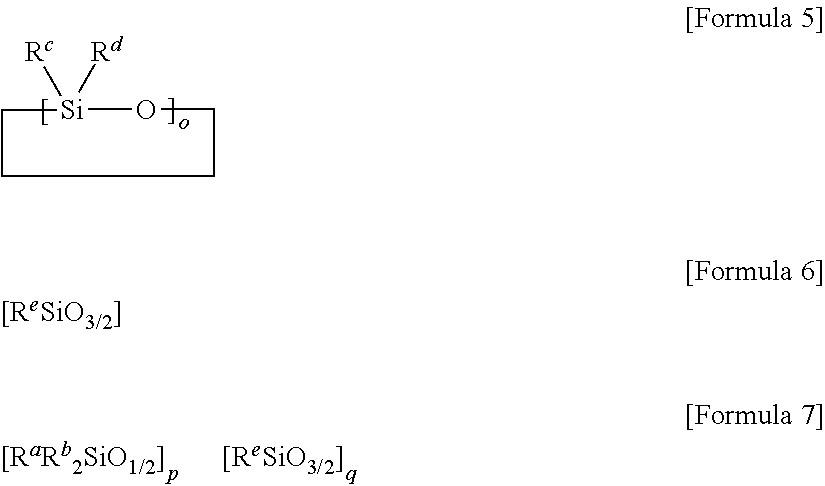Curable composition
- Summary
- Abstract
- Description
- Claims
- Application Information
AI Technical Summary
Benefits of technology
Problems solved by technology
Method used
Image
Examples
synthesis example 1
[0138]55.00 g of octamethylcyclotetrasiloxane, 120.4 g of octaphenylcyclotetrasiloxane, 9.6 g of tetramethyltetravinylcyclotetrasiloxane, 17.4 g of octaphenyl-polyhedral oligomeric silsesquioxane (octaphenyl-POSS) and 15.7 g of divinyltetramethyldisiloxane were mixed, and 0.6 mL of tetramethylammonium hydroxide (TMAH) was mixed into the mixture as a catalyst. Afterward, the mixture into which the catalyst was mixed was reacted at 115° C. for approximately 20 hours. A low molecular weight material was removed from the reaction product after reaction, thereby obtaining a transparent oil-type organopolysiloxane (A) represented by Formula A. The organopolysiloxane had a viscosity at 25° C. of 35,200 cP and a molecular weight of approximately 5,100. In addition, from the spectrum measured by 1H-NMR for the organopolysiloxane, a peak derived from an alkoxy group was not observed, and an acid value was measured at approximately 0.008.
[ViMe2SiO1 / 2]2[Me2SiO2 / 2]18[Ph2SiO2 / 2]15[ViMeSiO2 / 2]3[Ph...
synthesis example 2
[0139]An organopolysiloxane was synthesized by the method described in Synthesis Example 1, except that tetramethyltetravinylcyclotetrasiloxane was not used, and amounts at which octaphenyl-POSS and divinyltetramethyldisiloxane were mixed were changed to 8.7 g and 12.6 g, respectively. The organopolysiloxane was represented by Formula B, and present in transparent oil. The organopolysiloxane (B) had a viscosity at 25° C. of 19,600 cP and a molecular weight of approximately 5,000. In addition, from the spectrum measured by 1H-NMR for the organopolysiloxane, a peak derived from an alkoxy group was not observed, and an acid value was measured at approximately 0.009.
[ViMe2SiO1 / 2]2[Me2SiO2 / 2]20[Ph2SiO2 / 2]16[PhSiO3 / 2]2 [Formula B]
synthesis example 3
[0140]60.00 g of octamethylcyclotetrasiloxane, 106.96 g of octaphenylcyclotetrasiloxane, 17.44 g of octaphenyl-POSS and 12.56 g of divinyltetramethyldisiloxane were mixed, and 0.63 mL of tetramethylammonium hydroxide (TMAH) was mixed into the mixture as a catalyst. Afterward, the mixture into which the catalyst was mixed was reacted at 115° C. for approximately 20 hours, thereby obtaining a transparent oil-type polysiloxane represented by Formula C. The organopolysiloxane had a viscosity at 25° C. of 21,000 cP and a molecular weight of approximately 6,400. In addition, from the spectrum measured by 1H-NMR for the organopolysiloxane, a peak derived from an alkoxy group was not observed, and an acid value was measured at approximately 0.006 mg KOH / g.
[ViMe2SiO1 / 2]2[Me2SiO2 / 2]22[Ph2SiO2 / 2]15[PhSiO3 / 2]5 [Formula C]
PUM
| Property | Measurement | Unit |
|---|---|---|
| Acid value | aaaaa | aaaaa |
| Composition | aaaaa | aaaaa |
| Molar ratio | aaaaa | aaaaa |
Abstract
Description
Claims
Application Information
 Login to View More
Login to View More - R&D
- Intellectual Property
- Life Sciences
- Materials
- Tech Scout
- Unparalleled Data Quality
- Higher Quality Content
- 60% Fewer Hallucinations
Browse by: Latest US Patents, China's latest patents, Technical Efficacy Thesaurus, Application Domain, Technology Topic, Popular Technical Reports.
© 2025 PatSnap. All rights reserved.Legal|Privacy policy|Modern Slavery Act Transparency Statement|Sitemap|About US| Contact US: help@patsnap.com



